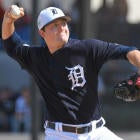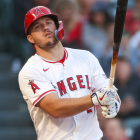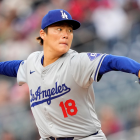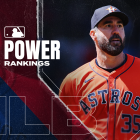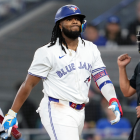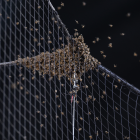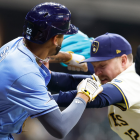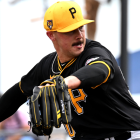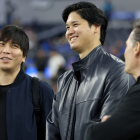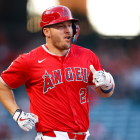With the regular season concluding, we've decided to take a look at each team's future -- not by using a crystal ball or other psychic abilities, but by evaluating their farm systems. Below you'll find our ranking of the top five prospects in the organization -- sorted by perceived future potential -- as well as five other players who fit various categories. Those categories are:
2020 contributor: A player who is likely to play a role for the big-league team next season.
Analyst's pick: A player who is a strong statistical performer and/or whose underlying measures are better than the scouting reports suggest.
Riser: A player on the way up.
Faller: A player on the way down.
One to watch: An interesting player to keep in mind (for whatever reason).
These rankings were compiled after talking with various industry sources about the systems (and players) in question. It should be acknowledged that this process is more art than science, and that there are limits to ordinal rankings. Still, it's an intuitive system, and our hope is that the write-ups will answer any questions by providing additional context and analysis of each player -- such as their pluses and minuses; the risk factors involved; and their estimated arrival date.
One last word on eligibility: we're following MLB's rookie guidelines by disqualifying any player with more than 130 big-league at-bats or 50 innings pitched.
The Detroit Tigers haven't posted a winning season since 2016 and are coming off their worst season in a long time -- thus making it likely they'll pick No. 1 in the draft for the second time in three years next summer. Not everything is sour for Tigers fans, however, as their farm system does feature a few high-quality arms who could reach the majors sooner than later. Here's a look at the top prospects in the Tigers' system:
1. Casey Mize, RHP
When Casey Mize was picked first overall in the 2018 draft, he dethroned former big-league closer Gregg Olson (No. 4 in 1988) as the highest player ever selected from Auburn. Mize shares a few commonalities with Olson -- an alma mater, of course, and the possession of a high-grade out pitch. Olson had one of the best curveballs in recent memory, while Mize has a trapdoor split-change that has more GIF potential than a waterskiing squirrel.
Mize's arsenal runs deeper than his splitter. He has three other offerings -- a fastball, a slider, and a cutter -- that grade as at least above-average. Those pitches often play up due to his polish. He has above-average command and has walked fewer than five percent of the batters he's faced so far as a professional.
The main concern with Mize is the universal one for pitchers: health. Unfortunately, this isn't theory ("he's a pitcher and pitchers get hurt") so much as a reality: Mize missed time this season due to shoulder inflammation, and has had other arm woes in the past, including a forearm strain that interfered with his sophomore season at Auburn. Bodies are fickle vessels prone to upheaval when tasked with crossing the waters of a big-league season, but past research suggests past injuries are the best predictor of future injuries -- meaning, in so many words, Mize might be more prone to injury than the standard pitcher.
A hearty and hale Mize is likely to debut in the majors next spring. He ought to develop into a No. 2 starter in short order, and his health will dictate if he's ever known as an ace.
2. Matt Manning, RHP
Matt Manning's father, Rich, played two seasons in the NBA during the '90s. Predictably, the younger Manning is tall (listed at 6-foot-6) and athletic. He even had enough game on the court to receive a scholarship offer to play college ball.
Manning instead chose baseball, but he still concerns himself with the arc he puts on the ball -- at least as it pertains to his signature pitch, a curveball often described as a "hammer." In addition to the curve, he has an above-average fastball and a developing changeup. Manning has done well to fill out his frame and improve upon his delivery, with this season seeing him post new single-season bests in innings pitched (133) and walk rate (2.6 per nine innings).
As with Mize, Manning is likely to debut for Detroit sometime next spring. Mize's injury history suggests Manning might be the safer of the two on a year-to-year basis.
3. Riley Greene, OF
The Tigers drafted Riley Greene with the fifth pick in June's draft on the strength of his bat. He then reached Class-A before turning 19, having hit nearly .300 in the low minors.
Although the Tigers played Greene almost exclusively in center field, the expectation is he'll end up in an outfield corner -- likely left due to his arm. His bat should play there provided he approaches his ceiling as a middle-of-the-order type who can hit for average and power.
The one concern about Greene's first exposure to pro ball was his tendency to strike out. He fanned in more than a quarter of his plate appearances in what's a small sample to be certain. It's not time to raise the red flag just yet, but do keep it in mind heading into next year.
4. Tarik Skubal, LHP
When southpaw Tarik Skubal throws his first big-league pitch, he'll become the fourth player from Seattle University to ever accomplish the feat. Skubal's path has been a rare one in other regards, too. He missed an entire collegiate season to Tommy John surgery, and in his return year he walked 56 batters in 80 innings. The Tigers (perhaps influenced by agent Scott Boras) pounced on him in the ninth round, and that decision has and will continue to pay dividends.
No player in the system improved their stock more in 2019 than Skubal, who threw a personal-best 122 innings across High- and Double-A while amassing a 2.42 ERA and a 4.84 strikeout-to-walk ratio. The rule of thumb is that command is the last aspect of a pitcher's arsenal to return after an elbow operation. Sure enough, Skubal has walked just over seven percent of batters he's faced as a pro -- a far cry from the 15.5 percent he walked as a junior.
Skubal has a well-built frame and he throws the ball from a high three-quarters slot. At release he might remind Tigers fans of former Detroit hurler Drew Smyly. His fastball has good carry and is considered his best offering, and he could boast two average or better breaking balls.
If Skubal can stay healthy -- we're legally obligated to include this on most pitcher comments -- then he could reach the majors as a mid-rotation starter quicker than you can say "Skubal Doo."
5. Isaac Paredes, INF
Fate is a funny thing. The Tigers acquired Isaac Paredes alongside Jeimer Candelario at the 2017 trade deadline, when they sent Justin Wilson and Alex Avila to the Chicago Cubs. Candelario has since fallen out of favor after a decent season-and-a-half as the everyday third baseman. Paredes, conversely, might soon end up being the solution at the hot corner.
Paredes' bread and soup are his bat-to-ball and on-base skills. This season, he nearly walked as often as he struck out -- and did so as a 20-year-old in Double-A who hit .282. The Tigers have cross-trained him at both left-side infield positions, but his build and lack of range suggest he's likely to play most of his games at third base heading forward.
Paredes should open 2020 at the Triple-A level. Provided the Tigers are OK with what he is -- a solid enough hitting prospect -- he should reach the majors before the summer ends.
2020 contributor: Alex Faedo, RHP
Yet another member of Detroit's Double-A rotation, Alex Faedo has a good slider and he posted a 5.36 strikeout-to-walk ratio in 22 starts. He's a short-strider with a shallow release point, however, which causes his stuff to play down. To wit, he permitted three more home runs (17) in 115 innings than Mize, Manning, and Skubal yielded in 254 innings combined. Faedo should reach the majors in 2020, though he may end up in the bullpen as the new Chaz Roe.
Analyst's pick: Beau Burrows, RHP
The Tigers drafted Beau Burrows No. 22 in the 2015 draft, or a few picks ahead of Walker Buehler and Mike Soroka. While those two were pitching well for contending teams, Burrows was stuck in Triple-A, where he notched a 5.51 ERA and permitted too many walks and home runs for anyone's comfort before an oblique injury ended his season prematurely. He has posted good fastball spin rates dating back to his amateur days, but his command and secondaries suggest he's probably more of a back-end starter or reliever. He's likely to debut in 2020.
Riser: Wenceel Perez, INF
We were tempted to give this spot to Skubal, too. But, in the interest of covering 10 prospects, we're instead giving the nod to switch-hitting shortstop Wenceel Perez. Perez can really run and won't celebrate his 20th birthday until the end of October -- meaning his statistics from 2019, while uninspiring, aren't too important. He's unlikely to ever hit for much power, so he'll need to continue to refine his approach at the plate to maximize his upside.
Faller: Franklin Perez, RHP
Franklin Perez was supposed to be the centerpiece of the Justin Verlander trade. Since coming over in August 2017, he's thrown all of 27 innings for the Tigers organization. Perez is only 21 years old, but continued shoulder woes are threatening his mid-rotation potential.
One to watch: Carlos Guzman, RHP
A converted infielder, Carlos Guzman appeared just seven times in 2019 before being shut down due to a forearm injury. When he's been on the mound -- we're talking a little over 100 innings for his career -- he's shown promise as an athletic changeup artist.













